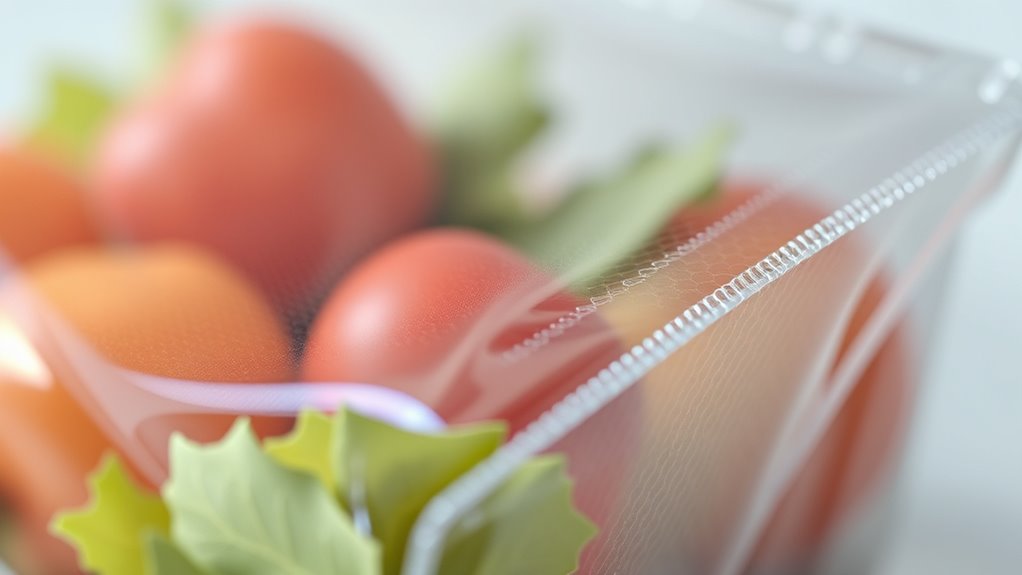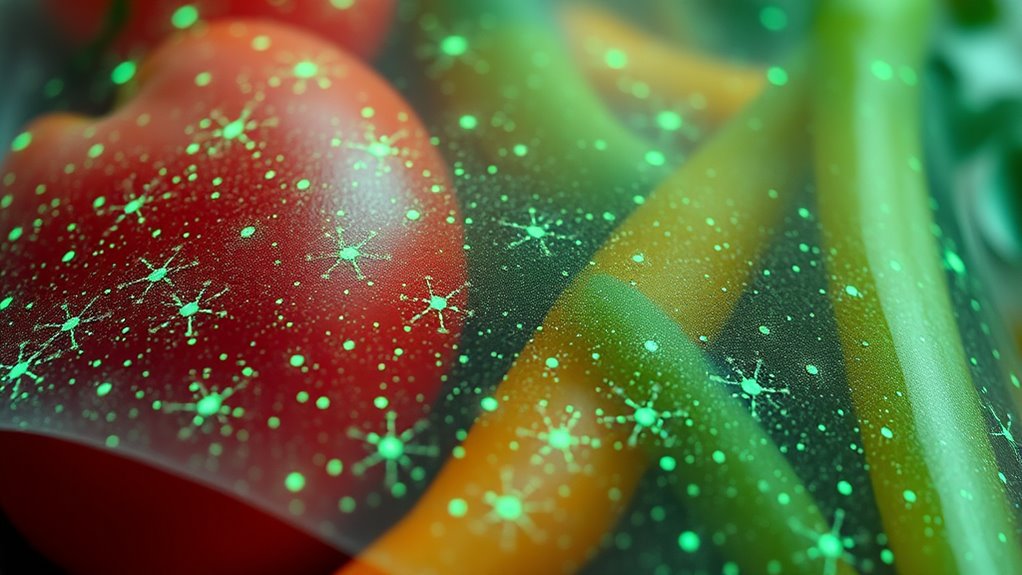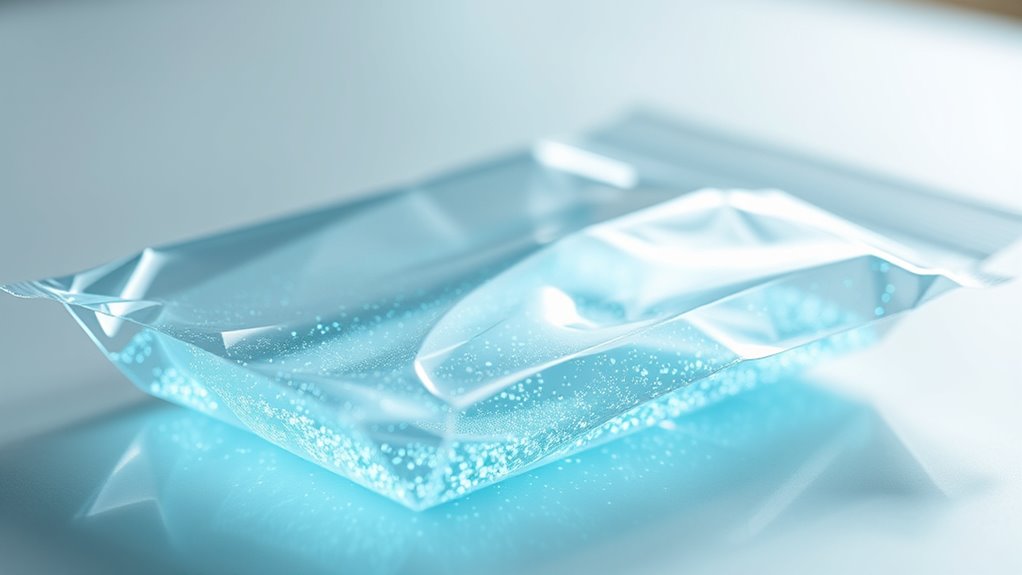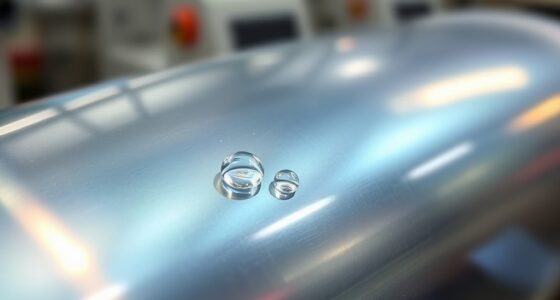Nanomachines in food packaging enable smart, sustainable materials that detect spoilage, microbial growth, and environmental changes in real-time. They respond instantly by releasing preservatives, changing color, or triggering protective actions, helping keep food fresh longer. By incorporating biodegradable nanomaterials and advanced sensors, packaging becomes eco-friendly while improving barrier and antimicrobial properties. Continuing to explore this innovative field reveals how nanotechnology is shaping safer, greener, and more efficient food preservation solutions.
Key Takeaways
- Nanomachines enable real-time monitoring of food freshness indicators like temperature, humidity, and microbial growth.
- Smart nanomaterials can detect spoilage signs and respond by releasing preservatives or changing packaging color.
- Incorporation of biodegradable nanomaterials enhances sustainability and reduces environmental impact in food packaging.
- Nanocoatings improve barrier properties and antimicrobial action, extending shelf life while maintaining eco-friendly standards.
- Industry standards and safety regulations are evolving to ensure responsible use of nanomachines in sustainable food packaging solutions.
The Role of Nanomachines in Enhancing Food Preservation

Nanomachines play an essential role in improving food preservation by actively monitoring and controlling storage conditions. When you store food with nanomachines embedded, they detect changes in temperature, humidity, and gas levels in real-time. These tiny devices can respond instantly, adjusting internal environments to prevent spoilage. For example, if humidity rises, nanomachines can trigger moisture-absorbing actions to keep food dry. They also identify early signs of microbial growth or chemical changes, alerting you or the system to potential spoilage before it becomes visible. This proactive approach helps extend shelf life considerably. Moreover, nanomachines can be programmed to detect specific pathogens, further safeguarding food safety. By continuously tracking and managing storage parameters, nanomachines ensure your food remains fresh, safe, and nutritious for longer periods, reducing waste and maintaining quality from farm to table.
How Nanomaterials Improve Barrier Properties in Packaging

Nanomaterials enhance barrier properties in food packaging by creating extremely thin, yet highly effective, layers that block the passage of gases, moisture, and contaminants. Their tiny size allows them to form dense, uniform coatings that traditional materials can’t achieve. For example, nanoclays and nanosilver particles create tortuous paths that gases and vapors struggle to pass through, markedly reducing permeability. This improves shelf life and maintains food freshness without adding weight or bulk. Additionally, nanocomposites can be integrated into plastics, strengthening the material while enhancing its barrier qualities. You’ll find these nanostructures in packaging that keeps oxygen out, moisture in, and bacteria away, all while remaining lightweight and flexible. The result is a smarter, more sustainable packaging solution that protects your food effectively. Incorporating industry trends helps manufacturers stay ahead in developing innovative, environmentally friendly packaging solutions.
Smart Sensors: Detecting Spoilage With Nanoscale Devices

Smart sensors at the nanoscale are revolutionizing food freshness detection by providing real-time, precise information about spoilage. These tiny devices can identify gases, acids, or bacteria that signal deterioration, alerting you immediately. Their high sensitivity guarantees early detection, reducing waste and preventing health risks. With wireless communication, sensors can send updates directly to your smartphone or storage systems. You can monitor multiple parameters simultaneously, making spoilage detection more reliable. Additionally, nanosensors are integrated seamlessly into packaging, avoiding any impact on food quality or appearance. Their durability ensures consistent performance throughout the product’s shelf life. Overall, nanoscale smart sensors empower you to make informed decisions, maintain freshness, and enhance food safety efficiently.
A new sensor technology enhances food safety by detecting contaminants at an earlier stage, further minimizing risks.
Eco-Friendly and Biodegradable Nanocomposites for Sustainable Packaging

You can choose from biodegradable materials like bioplastics and natural fibers to create eco-friendly packaging. These options help reduce plastic waste and lessen environmental impact. Plus, they can improve packaging durability while supporting sustainable practices. Incorporating organic and natural juices into packaging design can also promote health-conscious branding and appeal to eco-aware consumers.
Biodegradable Material Options
As sustainability becomes a top priority, researchers are developing biodegradable nanocomposites that combine eco-friendly materials with nanotechnology to create sustainable packaging solutions. These materials break down naturally, minimizing environmental impact while maintaining strength and functionality. You can find options like polylactic acid (PLA), made from renewable resources such as cornstarch, and cellulose-based nanocomposites derived from plant fibers. Other promising materials include chitosan, a natural polymer with antimicrobial properties, and starch-based nanocomposites that are both biodegradable and cost-effective. These options are enhanced with nanomaterials that improve barrier properties and durability. Embracing these biodegradable materials helps reduce plastic waste, supports circular economies, and aligns packaging with eco-conscious consumer demands.
Reducing Plastic Waste
Biodegradable nanocomposites offer a promising solution to the growing problem of plastic waste in packaging. By incorporating natural polymers like PLA, PHA, or starch with nano-enhanced materials, you can create packaging that breaks down more quickly and safely in the environment. These nanocomposites maintain necessary barrier and mechanical properties while reducing reliance on traditional plastics. You’ll find that their enhanced surface properties improve recyclability and compostability, making disposal more eco-friendly. Using nanotechnology, you can also develop materials that respond to environmental conditions, accelerating degradation when needed. This approach not only cuts down plastic waste but also supports a circular economy by enabling packaging to return to nature without harmful residues. Understanding sustainability is essential for designing future-proof packaging solutions. Ultimately, adopting biodegradable nanocomposites helps you contribute to a cleaner, more sustainable planet.
Enhancing Packaging Durability
Enhancing packaging durability with eco-friendly nanocomposites involves integrating natural polymers and nanomaterials to create packaging that is both strong and sustainable. By combining biodegradable components with nanotechnology, you can develop materials that withstand wear and tear while minimizing environmental impact. These nanocomposites improve barrier properties, resist moisture, and increase mechanical strength without sacrificing sustainability. You can also tailor properties for specific needs, like extended shelf life or enhanced protection. This approach reduces reliance on traditional plastics, promoting eco-friendly waste management. Incorporating nanomaterials such as cellulose nanocrystals or biopolymer nanocomposites ensures durability without harming the environment. Nanotechnology enables the precise manipulation of materials at the nanoscale, further enhancing the performance of sustainable packaging solutions.
Innovations in Active Packaging Using Nanotechnology

Innovations in active packaging with nanotechnology are transforming how food stays fresh and safe. You’ll find that antimicrobial nanocoatings effectively inhibit bacteria, extending shelf life. Additionally, responsive packaging mechanisms can detect changes in quality and trigger protective actions automatically. As AI advances continue to improve safety measures, these smart packaging solutions become even more reliable and effective.
Antimicrobial Nanocoatings Efficacy
Antimicrobial nanocoatings have revolutionized active food packaging by providing a powerful barrier against microbial contamination. These coatings effectively inhibit bacteria, fungi, and viruses, extending shelf life and ensuring food safety. Their efficacy depends on the type of nanomaterials used, such as silver, zinc oxide, or chitosan, which release antimicrobial agents gradually. You’ll find that nanocoatings can be integrated into various substrates, maintaining transparency and flexibility. Additionally, nanocoatings can reduce the need for chemical preservatives, making packaging more eco-friendly. Their antimicrobial action is often enhanced by increased surface area at the nanoscale, boosting contact with microbes. Overall, nanocoatings offer a promising, sustainable approach to combating spoilage and contamination in food packaging.
Enhanced antimicrobial activity is further supported by the use of specific nanomaterials that target a broad spectrum of microorganisms.
- Enhanced antimicrobial activity due to high surface area
- Compatibility with multiple packaging materials
- Reduced chemical preservative requirements
- Long-lasting microbial protection
- Environmentally friendly and safe for consumers
Responsive Packaging Mechanisms
Responsive packaging mechanisms harness nanotechnology to create smart systems that actively respond to changes in the food environment. These innovations detect factors like temperature, humidity, pH, or gas levels and adjust accordingly to preserve freshness and safety. For example, nanomaterials embedded in packaging can release preservatives or antimicrobials when spoilage signals are detected. Others change color to alert you to contamination or spoilage, providing real-time information without opening the package. You benefit from enhanced safety, extended shelf life, and reduced waste. These nanotechnology-driven systems are highly sensitive and precise, enabling packaging to adapt dynamically to the food’s condition. Additionally, the integration of electric heated mattress pads demonstrates how safety features and energy efficiency can be incorporated into everyday products, highlighting the importance of smart design and material innovation. As a result, they offer a proactive approach to food preservation, aligning with sustainability goals and consumer needs for transparency and freshness.
Challenges and Safety Considerations of Nanomaterials in Food Packaging

While nanomaterials offer exciting advantages for food packaging, they also present significant challenges and safety concerns that must be carefully addressed. You need to take into account potential toxicity, as nanoparticles can migrate into food and affect health. Environmental impact is another issue; nanomaterials may persist and accumulate, harming ecosystems. Regulatory frameworks are still evolving, making it difficult to assure consistent safety standards. Manufacturing processes can introduce contaminants or inconsistencies, raising quality concerns. Public perception also matters—consumers may mistrust nanomaterials without proper understanding. To navigate these challenges, focus on thorough testing, transparent communication, and developing eco-friendly, safe nanomaterials. Ultimately, balancing innovation with safety ensures nanotechnology benefits without compromising health or the environment.
- Toxicity and health risks
- Migration into food
- Environmental impact
- Regulatory gaps
- Public perception and acceptance
Future Perspectives: Integrating Nanomachines Into Industry Standards

Integrating nanomachines into industry standards is vital for realizing their full potential in food packaging. To do this, you need clear regulations, quality benchmarks, and safety protocols that guarantee consistent performance and consumer trust. Collaboration between researchers, manufacturers, and regulatory agencies will facilitate this process. Establishing standardized testing methods helps verify nanomachine functionality and safety. Additionally, public awareness and transparency are essential for gaining consumer acceptance. The table below highlights key areas for integration:
| Area | Focus |
|---|---|
| Regulatory Framework | Developing guidelines for nanomachine use and safety standards |
| Quality Control | Implementing consistent testing and validation processes |
| Industry Collaboration | Sharing best practices and technological advancements |
| Consumer Engagement | Educating the public about benefits and safety measures |
A thorough understanding of nanomachines and their capabilities is necessary to develop appropriate safety protocols and ensure effective integration into industry standards.
Case Studies Demonstrating the Impact of Nanotechnology on Food Safety

Real-world examples highlight how nanotechnology is transforming food safety through innovative packaging solutions. For instance, nanosensors detect spoilage or contamination in real-time, alerting you immediately. Silver nanoparticles are incorporated into packaging materials to inhibit bacterial growth, extending shelf life and reducing foodborne illnesses. In another case, packaging with embedded nanomaterials can absorb harmful gases, preventing spoilage and maintaining freshness. You might also encounter nanostructured coatings that make packaging more durable and resistant to punctures or leaks. finally, smart labels powered by nanotech can provide detailed information about freshness and safety, empowering you to make informed choices. These case studies demonstrate nanotechnology’s potential to improve safety, reduce waste, and enhance your overall food experience.
Frequently Asked Questions
Are Nanomachines Safe for Human Health and Environmental Exposure?
Nanomachines in food packaging can be safe if properly tested and regulated. You should know that researchers assess their potential health and environmental impacts thoroughly before approval. While some nanomaterials might pose risks, ongoing studies aim to minimize these concerns. As a consumer, it’s important to stay informed and trust regulatory agencies that guarantee safety standards are met, making these innovative materials beneficial and secure for everyone.
How Cost-Effective Are Nanotechnology-Based Food Packaging Solutions?
Did you know nanotechnology can cut packaging costs by up to 20%? You’ll find that nanotech-based food packaging solutions are increasingly cost-effective, especially over time. They reduce waste, extend shelf life, and require less material, saving money in the long run. While initial investments might be higher, the efficiency and durability they offer can lead to significant savings, making them a smart choice for both producers and consumers.
Can Nanomachines Be Customized for Specific Food Types?
Yes, nanomachines can be customized for specific food types. You can tailor their properties to target particular spoilage bacteria, control gas exchange, or release preservatives as needed. This customization guarantees ideal preservation and safety for different foods. By adjusting their design and functionality, you make sure the nanomachines work effectively with various products, enhancing freshness, extending shelf life, and reducing waste.
What Are the Potential Regulatory Hurdles for Commercial Nanomaterial Use?
Think of regulations as the guardrails guiding your innovation, ensuring safety without stifling progress. You might face hurdles like strict safety assessments, environmental impact evaluations, and approval delays. Managing different countries’ policies complicates things further. To succeed, you need thorough testing, transparent communication, and compliance with existing standards. While these challenges seem daunting, they’re essential to protect consumers and the environment, paving the way for responsible nanomaterial use in food packaging.
How Do Nanomachines Affect the Recyclability of Packaging Materials?
Nanomachines can both improve and complicate the recyclability of packaging materials. They enable smarter features like enhanced barrier properties or active freshness control, which can make recycling more efficient. However, their tiny size and integration into materials may complicate separation processes, potentially contaminating recycling streams. You’ll need clear regulations and advanced recycling technologies to guarantee nanomachine-infused packaging remains environmentally friendly and recyclable.
Conclusion
As you explore nanomachines in food packaging, it’s like witnessing a quiet revolution unfold—where smart materials and sensors seamlessly protect your food while caring for the planet. Imagine packaging that detects spoilage and biodegrades naturally, all thanks to tiny innovations working behind the scenes. This convergence of technology and sustainability hints at a future where your food stays fresher longer, and the environment stays healthier—a coincidence of progress and purpose.









